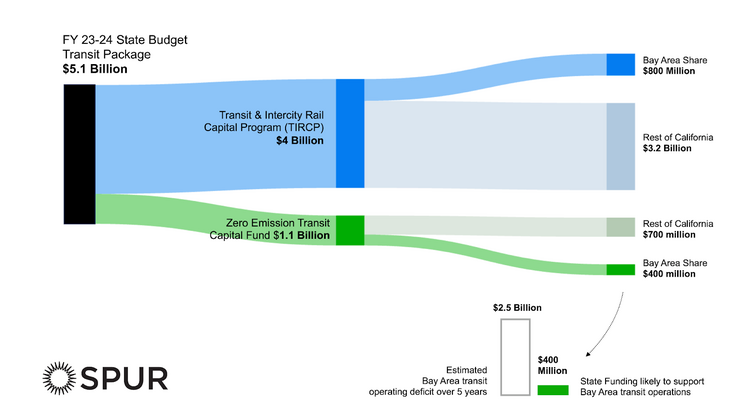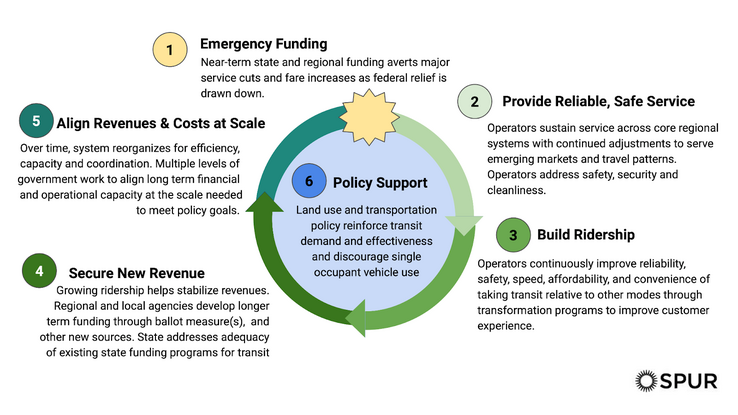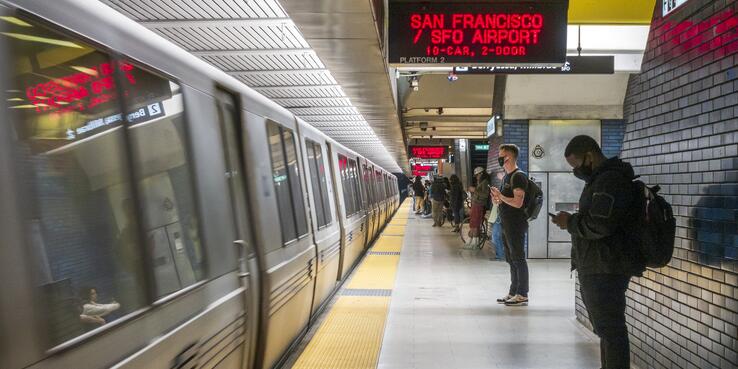On June 28, Governor Newsom signed California’s 2023–2024 budget into law, while riding BART. The governor’s budget approval, along with its symbolic venue, was the culmination of a hard-fought campaign by the Survive and Thrive Coalition, a statewide group of advocates, led by SPUR, Transform, Bay Area Council, and Seamless Bay Area, that urged the State of California to provide emergency operating funding so that transit agencies can keep buses and trains running.
The state budget will provide $400 million to the Bay Area for transit operations, a welcome investment that allows agencies to avert the most immediate cuts. But that figure is far short of the $2.5 billion needed to avoid service cuts in the next five years.
What does the budget include, and how much will the Bay Area get for transit operations?
The state’s budget provides $5.1 billion in transit funding. The transit package restores a promised $2 billion augmentation of the Transit and Intercity Rail Capital Program (TIRCP) from the General Fund, bringing the TIRCP total to $4 billion to be distributed through 2025. The budget also includes a new, $1.1 billion appropriation to the Zero-Emission Transit Capital Program to be distributed through 2026. The budget makes both fund sources fully flexible so that they can be used either for capital projects or for transit operations, a critical turning point because the state has historically played a much larger role in funding projects than in funding service.
The Bay Area’s Share of State Funding and Fundings Needs
Of the $5.1 billion transit funding package included in the state budget, approximately $400 million could go to supporting Bay Area transit operations, a significant amount, but much less than the total projected need.

The budget and associated trailer bill, the implementing legislation for the state budget, outline how this money will be apportioned across the state. Under the prescribed formulas, the Bay Area will receive approximately $800 million in TIRCP funds, which were previously anticipated and are likely to be used as matching capital funds to leverage billions in federal grants for projects like BART Core Capacity and BART to Silicon Valley. The region will also receive $400 million in funding under the new Zero-Emission Transit Capital (ZETC) Program. Because this funding is new, it is more likely to be flexed to support transit operations. This means that the amount of state funding that the Bay Area can actually use to avoid service cuts is just $400 million. This infusion of funds, which is significant and needed, especially in a deficit year, will help the region avoid the near-term impacts of a transit fiscal cliff. However, it falls far short of the amount needed to resolve the $2.5 billion deficit that transit operators anticipate over the coming five years.
How should the emergency funds be used?
The trailer bill intends for funds to be “one-time, multiyear bridge funding” to avoid service cuts and preserve ridership while longer-term solutions to stabilize transit finances are identified. The bill also directs regional transportation planning agencies, like the Metropolitan Transportation Commission (MTC), to distribute funds in a way that avoids service cuts on the region’s largest systems and ensures the continued availability of services for transit-dependent riders. To receive funding, these regional agencies must submit planning and reporting documents to the California State Transportation Agency (CalSTA). These documents include both short- and long-term financial plans that justify how relief funding will be used and that outline the steps the region is taking to build ridership and stabilize transit finances.
Overall, the requirements included in the trailer bill are a good start, but more will need to be done both to ensure that funds are used effectively and that transit operators continue down the path of reform and transformation. SPUR strongly supports provisions that focus on avoiding service cuts on high-ridership systems and routes used by transit-dependent riders. If funds aren’t used to avert imminent service cuts, transit will still fall into a death spiral and set disadvantaged groups back.
SPUR had hoped that the budget would require MTC and transit agencies to scale up and accelerate efforts to provide a more seamless transit experience as a means to build ridership. However, the statewide nature of the bill and the limited amount of funding available made the inclusion of more specific accountability reforms challenging. Although the bill does not directly compel detailed reforms, the requirement that MTC develop and submit a series of financial plans to CalSTA is a significant positive step. The requirement reinforces the work the region has already committed to in MTC’s Transit Transformation Action Plan, and it creates an additional layer of external oversight and approval at the state level to ensure that the Bay Area stays on track. Of specific note, the bill does require the initial short-term financial plan submitted to CalSTA to report on “opportunities for improving coordination amongst transit operators, including, but not limited to, consolidation of agencies or reevaluation of network management and governance structure,” an action that SPUR has called for.
What’s next?
The Bay Area is unfortunately still facing a sizable gap in operating funds over the next five years just to maintain existing transit service levels. The state was always clear that it could not fully fund transit’s operating needs in the just-signed budget. Now it's time for the region to do its part.
Senator Scott Wiener has introduced a bill (SB 532) that would require the Bay Area Toll Authority to raise the region’s bridge tolls by $1.50 for all state-owned bridges, except the Golden Gate Bridge, for five years. This temporary increase is expected to raise $915 million and is intended specifically for transit operations. The bill requires the significant majority of funds to go to maintaining existing levels of service and improving the safety, cleanliness, security, and reliability of the transit system. The bill authorizes the use of a smaller subset of funds to implement programs, outlined in MTC’s Transit Transformation Action Plan, to improve customer experience and coordination among the region’s transit operators.
SPUR is a co-sponsor of this emergency measure to temporarily increase bridge tolls, and we support the proposal to spend the majority of funds to avert catastrophic service cuts and make changes that improve customer experience.
On the whole, SB 532 advances equity because it primarily and directly benefits transit riders, who are more likely to be low-income than drivers. Nevertheless, SPUR is working with our partners to ensure the inclusion of equity provisions such as toll caps or discounts and reforms to fee and penalty structures that can help limit the impact of the temporary toll increase on lower-income drivers.
Working toward a sustainable business model
In the longer term, there is significant work to do to transition transit in California to a sustainable business model. Despite the centrality of transit to the state’s climate, air quality, housing goals, and equity goals, California has not invested in transit at levels comparable to those of other states. Fortunately, the budget trailer bill takes an important step to address how the state can achieve its goals for transit by enacting provisions in SB 761, a bill sponsored by Assembly Transportation Committee Chair Laura Friedman. The bill would require CalSTA to convene a statewide transit transformation task force by the start of 2024. The task force would address the funding that transit needs to achieve fiscal stability and meet state goals while also considering policies to increase ridership and improve customer experience.
Building a Sustainable Business Model for Transit
Emergency funding is the first step to reverse transit’s “death spiral” and to begin the transition to a more sustainable business model. Getting all the way there will take sustained effort and time.

This statewide approach complements ongoing work in the Bay Area. Survive and Thrive: Roadmap to a Sustainable Business Model for Bay Area Public Transit, a report produced by MTC and transit operators on the basis of an initial draft by SPUR, lays out a conceptual 10-year program to improve customer experience and build ridership, control costs, and identify new, sustainable sources of funding for transit. The report points to a path of good decision making, sustained improvements, and thoughtful reforms that can get us to the system we need. The Bay Area has taken the initial steps by adopting the Transformation Action Plan, establishing a regional network management structure, and beginning work on a connected network plan. Securing transit’s future will require sustained commitment from MTC and operators as well as local, regional, and state policymakers and advocates.
